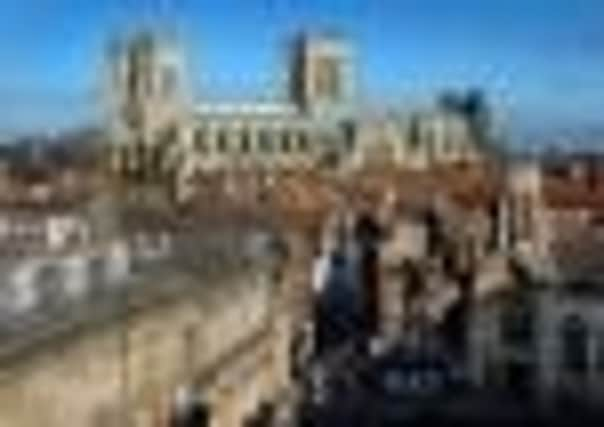City that patiently reinvents itself


On page 11 of a learned publication called Why York is Special, the thought occurs that the title could be a misnomer.
It quotes George Pace, an eminent architect of his time. “For nearly 2,000 years York has been lived in, has suffered innumerable vicissitudes and has witnessed constant pulling down and rebuilding”. Then he puts the boot in: “There are very few individual buildings of outstanding architectural worth. The medieval churches hardly compare with those of Norwich. The medieval houses and streets are rather pathetic seen against Lavenham or Ludlow. The Georgian buildings do not equal those of Edinburgh, Dublin and Bath; while London, Leeds, Halifax, Manchester, Liverpool and Scarborough have far better 19th century buildings.”
Advertisement
Hide AdAdvertisement
Hide AdWith that kind of endorsement the reader is left wondering, how is it then that York is the second most visited city in England? For an explanation, Pace, the critic, becomes Pace, the admirer: “Minster, churches, chapels, ruins, Assembly Rooms, Mansion House, public buildings, shops and houses all cheek by jowl, all bounded and enclosed by the Bar Walls and Gates, produce a city having an Aesthetic very much greater than the sum of the parts and unsurpassed in this land.”


There’s a human scale to York which isn’t just about narrow streets and intimate corners, restrained architecture (apart from a few modern eyesores) and its compact hotch-potch of styles reflecting those who came centuries before millions of tourists.
In the same booklet there are quotations from the late Professor Patrick Nuttgens, who was hugely influential in the city’s conservation. “The real secret of York is this – it is full of quite extraordinary characters heavily disguised as normal folk.” They could in turn be infuriating and parochial, sceptical and charming, blunt and visionary, but invariably friendly.
In the early 1960s, Nuttgens became director of the Institute of Advanced Architectural Studies at the city’s new university. A local sage marked the cards of arriving academics. “You should know, as you start this institution, that York has seen off the Romans, the Anglo-Saxons, the Vikings, the Normans, and the Roundheads, and if you think your university will make the slightest difference to the place, forget it now!”
Advertisement
Hide AdAdvertisement
Hide AdThat last bit has proved to be utterly wrong. With the university as a partner, York has become a centre for the development of knowledge-based industries. The campus’s Science City has created inward investment and thousands of jobs, especially in bioscience, computer-driven industries, heritage technology, and cultural businesses.


On the other hand you can still find those who seem unmoved by progress, and take the past and their surroundings for granted. An acquaintance, born and bred in the area, admits that, having just reached 50, he still hasn’t completed, on foot, a circuit of the City Walls – “2,000 years in two miles”, as a sign puts it. Somehow, he and his wife always get diverted by the shops, another reason why author Sir Ron Cooke can justify his title Why York is Special. For a relatively small place, he says the city punches above its weight in retailing. Within the historic centre it offers a mix of quality family-owned stores, upmarket national names such as Vivienne Westwood, and specialists like Barnitts, a labyrinthine monument to hardware, the leather goods of 171-year-old Robson & Cooper, and, almost next door, Banks music shop, founded in 1756, the year Mozart was born.
Drivers will agree that York is special – a special place for congestion. In several areas vehicles are pretty much banned altogether. The council’s park and ride system provides one solution, and the bicycle is challenging the car more than ever, helped by designated routes and rising fuel prices. This year, Cycling City York aims to increase overall bike use by 25 per cent, including journeys to school and work.
One of York’s 1,500 listed buildings is doing its bit for a greener environment. A former electricity substation next to Lendal Bridge has become the home of a bike rescue and cyclist service, renamed the Hub Station and costing £300,000. In five years it’s already taken 10,000 machines off the scrapheap and either restored and resold them, or used them for spares.
Advertisement
Hide AdAdvertisement
Hide AdIt’s the first project of its kind in the country and another example of how York reinvents itself, at its own pace.
THINGS TO SEE AND DO AROUND THE CITY
* Yorkwalk offers about 20 tours of the city on foot. Go in search of the Romans, Henry VIII, Richard III, Guy Fawkes, and the origins of the Minster. Explore the City Walls, and Jewish heritage sites, or there are literary, chocolate-making, bloody execution, and historic toilet tours, among others. www.yorkwalk.co.uk
* The Association of Voluntary Guides provides free two-hour walking tours.
* The lovely 19th-century De Grey Rooms, next to the Theatre Royal, used to house the officers’ mess of the Yorkshire Hussars. The building later became a venue for balls, concerts and parties, and now it’s back in the swing. The newly-restored ballroom is hosting 1940s big band nights, Jive Nights, and Tea Dances. It also hires costumes.
* There’s a choice of self-guided cycle tours around the city and surrounding area, and including accommodation, baggage transfer, and top-quality bikes. For details visit www.cycleyorkshire.com